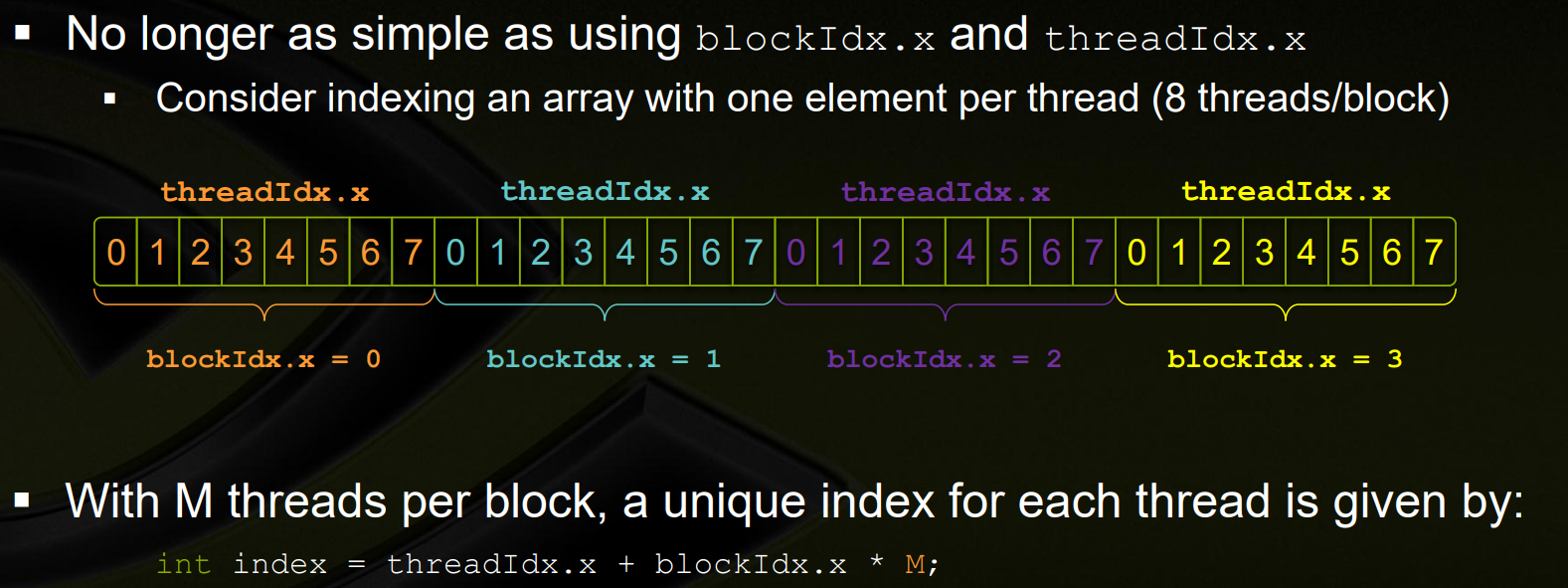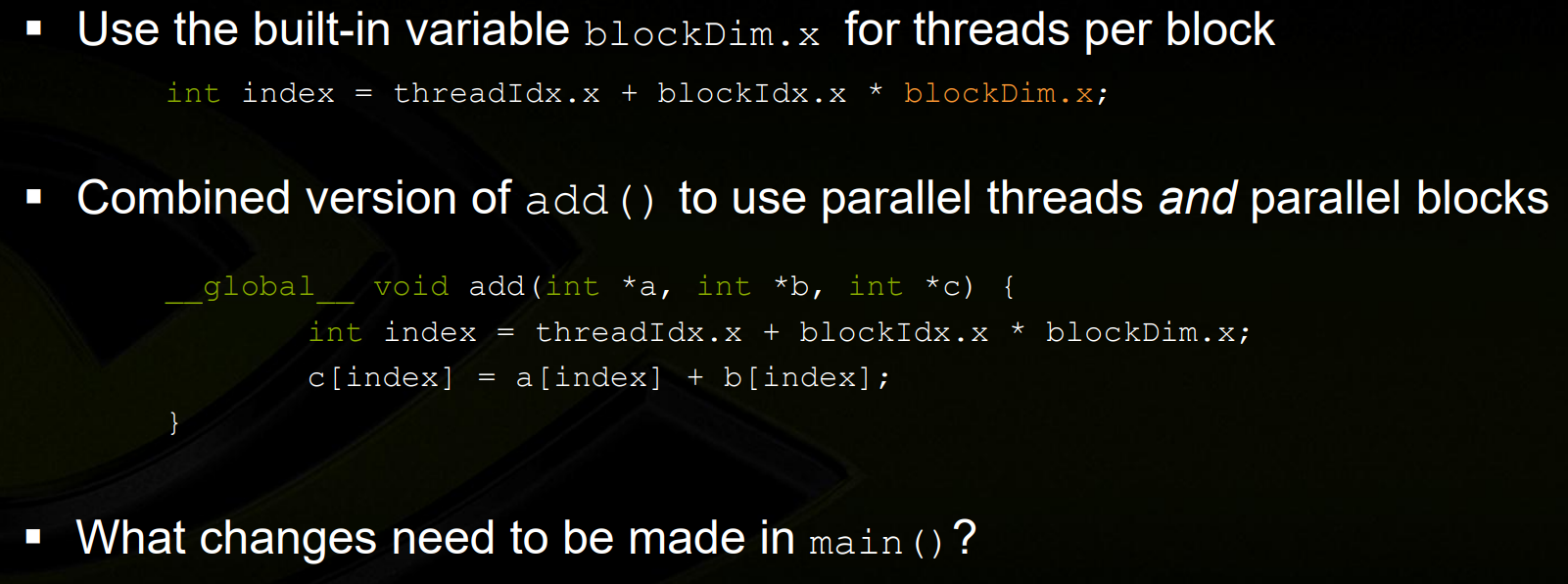Helpful Links
Nvidia System Management Interface
GPUDirect RDMA Access Example Code
Mellanox GPUDirect RDMA Example
RDMA Aware Programming User Manual (has a great RDMA architecture overview) NOTE This also includes how Infiniband works.
https://stackoverflow.com/questions/52125610/visual-studio-remote-linux-headers
Using Nvidia SMI
Run from Windows: c:\Windows\System32\DriverStore\FileRepository\nvdm.inf_amd64_3349a8117b680632>nvidia-smi.exe
OUTPUT
c:\Windows\System32\DriverStore\FileRepository\nvdm.inf_amd64_3349a8117b680632>nvidia-smi.exe
Wed Nov 10 15:47:38 2021
+-----------------------------------------------------------------------------+
| NVIDIA-SMI 471.35 Driver Version: 471.35 CUDA Version: 11.4 |
|-------------------------------+----------------------+----------------------+
| GPU Name TCC/WDDM | Bus-Id Disp.A | Volatile Uncorr. ECC |
| Fan Temp Perf Pwr:Usage/Cap| Memory-Usage | GPU-Util Compute M. |
| | | MIG M. |
|===============================+======================+======================|
| 0 Quadro T1000 WDDM | 00000000:01:00.0 Off | N/A |
| N/A 52C P8 2W / N/A | 287MiB / 4096MiB | 0% Default |
| | | N/A |
+-------------------------------+----------------------+----------------------+
+-----------------------------------------------------------------------------+
| Processes: |
| GPU GI CI PID Type Process name GPU Memory |
| ID ID Usage |
|=============================================================================|
| 0 N/A N/A 3360 C+G ...ser\Application\brave.exe N/A |
+-----------------------------------------------------------------------------+
Processes is a list of processes having compute or graphics context on the device. Compute processes are reported on all the fully supported products. Reporting for Graphics processes is limited to the supported products starting with Kepler architecture. Each Entry is of format <GPU Index> <PID> <Type> <Process Name> <GPUMemory Usage>"
- GPU Index - Represents NVML index of the device?
- PID Represents process ID corresponding to the active compute or graphics context?
- Type - Displayed as "C" for compute process, "G" for graphics process, and "C+G" for the procses having both compute and graphics contexts
- Process Name - Represents process name for the compute or graphics process
- GPU Memory Usage - Amount of memory used on the device by the context. Not available on Windows when running in WDDM mode because Windows KMD manages all memory not Nvidia driver
Notes on CUDA Programming
Overview


At its core CUDA has three key abstractions: - a hierarchy of thread groups - shared memories - barrier synchronization
This decomposition preserves language expressivity by allowing threads to cooperate when solving each sub-problem, and at the same time enables automatic scalability. Indeed, each block of threads can be scheduled on any of the available multiprocessors within a GPU, in any order, concurrently or sequentially, so that a compiled CUDA program can execute on any number of multiprocessors as illustrated by Figure 3, and only the runtime system needs to know the physical multiprocessor count.

Note: A GPU is built around an array of Streaming Multiprocessors (SMs) (see Hardware Implementation for more details). A multithreaded program is partitioned into blocks of threads that execute independently from each other, so that a GPU with more multiprocessors will automatically execute the program in less time than a GPU with fewer multiprocessors.
Kernels
CUDA C++ extends C++ by allowing the programmer to define C++ functions, called kernels, that, when called, are executed N times in parallel by N different CUDA threads, as opposed to only once like regular C++ functions.
The following sample code, using the built-in variable threadIdx, adds two vectors A and B of size N and stores the result into vector C.
// Kernel definition
__global__ void VecAdd(float* A, float* B, float* C)
{
int i = threadIdx.x;
C[i] = A[i] + B[i];
}
int main()
{
...
// Kernel invocation with N threads
VecAdd<<<1, N>>>(A, B, C);
...
}
Global Keyword
The global keyword indicates a function that runs on the device and is called from host code
How nvcc separates code
nvcc separates source code into host and device components. Device functions (e.g. mykernel()) are proccesed by the Nvidia compiler while host functions (e.g. main()) are processed by standard host compiler (gcc, cl, etc)
Thread Hierarchy
For convenience, threadIdx is a 3-component vector, so that threads can be identified using a one-dimensional, two-dimensional, or three-dimensional thread index, forming a one-dimensional, two-dimensional, or three-dimensional block of threads, called a thread block. This provides a natural way to invoke computation across the elements in a domain such as a vector, matrix, or volume.
CUDA Runtime
The runtime is introduced in CUDA Runtime. It provides C and C++ functions that execute on the host to allocate and deallocate device memory, transfer data between host memory and device memory, manage systems with multiple devices, etc. A complete description of the runtime can be found in the CUDA reference manual.
The runtime is built on top of a lower-level C API, the CUDA driver API, which is also accessible by the application. The driver API provides an additional level of control by exposing lower-level concepts such as CUDA contexts - the analogue of host processes for the device - and CUDA modules - the analogue of dynamically loaded libraries for the device. Most applications do not use the driver API as they do not need this additional level of control and when using the runtime, context and module management are implicit, resulting in more concise code. As the runtime is interoperable with the driver API, most applications that need some driver API features can default to use the runtime API and only use the driver API where needed. The driver API is introduced in Driver API and fully described in the reference manual.
The runtime is implemented in the cudart library, which is linked to the application, either statically via cudart.lib or libcudart.a, or dynamically via cudart.dll or libcudart.so. Applications that require cudart.dll and/or cudart.so for dynamic linking typically include them as part of the application installation package. It is only safe to pass the address of CUDA runtime symbols between components that link to the same instance of the CUDA runtime.
Questions
- What is NVML Index?
- What is WDDM mode?
- What is Windows KMD?
What is a Graphics Context?
See https://stackoverflow.com/a/23087951/4427375
A GPU context is described here. It represents all the state (data, variables, conditions, etc.) that are collectively required and instantiated to perform certain tasks (e.g. CUDA compute, graphics, H.264 encode, etc). A CUDA context is instantiated to perform CUDA compute activities on the GPU, either implicitly by the CUDA runtime API, or explicitly by the CUDA device API.
What is a PCIe Root Complex?
https://www.quora.com/What-is-a-PCIe-root-complex?share=1
How does PCIe Enumeration Work?
https://www.quora.com/What-is-PCIE-enumeration/answer/Satish-Kumar-525?ch=15&oid=31389493&share=44585235&target_type=answer
NVMe over PCIe vs Other Protocols
https://www.quora.com/Is-NVMe-faster-than-PCIe/answer/Mike-Jones-169?ch=15&oid=193548046&share=a587ff45&target_type=answer
What is a PCIe Function?
https://www.quora.com/What-is-a-PCIe-function/answer/Udit-Khanna-2?ch=15&oid=58319695&share=c7f066e5&target_type=answer
PCIe-Bus and NUMA Node Correlation
https://social.msdn.microsoft.com/Forums/en-US/fabb05b7-eb3f-4a7c-91c5-1ced90af3d0c/pciebus-and-numanode-correlation
How does the root complex work?
https://codywu2010.wordpress.com/2015/11/29/how-modern-multi-processor-multi-root-complex-system-assigns-pci-bus-number/
What is PCIe P2P?
https://xilinx.github.io/XRT/master/html/p2p.html
What is the difference between a thread and a block?
https://stackoverflow.com/questions/16635587/whats-the-difference-between-a-thread-in-a-block-and-a-warp32-threads
A block is used to run things in parallel and for each block there is one thread. Each parallel invocation of a kernel is a block and a set of blocks is a grid.
You can also run multiple threads per block.


